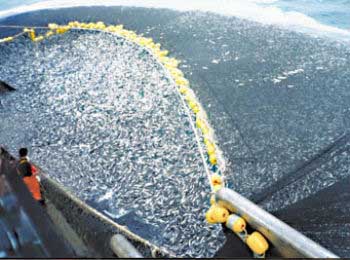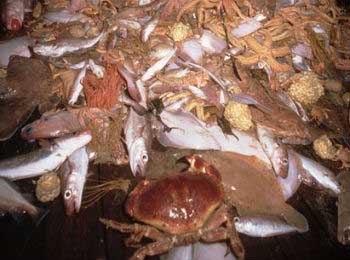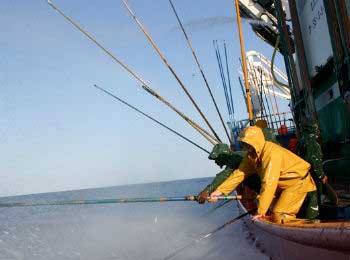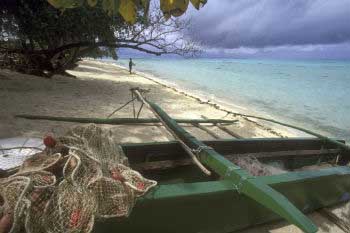When we speak about destructive fishing techniques, we refer to seabed devastation, species overexploitation and non-selective fishing. This past 8th June was the World Oceans Day, on which the aim was to raise awareness and remedy the current situation. Its 2014 Theme was “Together we have the power to protect the ocean.”
Oceans acidification is increasing at a dramatic pace, contributing to the extinction of vegetal and animal species which, together with overexploitation and destructive fishing methods, is undermining our seas health.
According to FAO, “Fisheries management should promote the maintenance of the quality, diversity and availability of fishery resources in sufficient quantities for present and future generations in the context of food security, poverty alleviation and sustainable development (…)States should prevent overfishing (…)” Despite these recommendations, the real situation is very different.
Types of destructive fishing:

Trawling: It consists of throwing big nets into the seabed, which are ballasted and then pulled for their collection, so they capture everything in their path. This includes species which will be of no use, coral destruction, etc. It is one of the least selective fishing methods, and very harmful to sea bottoms. It is a typical Western type of fishing. Many species, even those endangered, are captured without a reason and then thrown back into the sea when many times are already dead. These “collateral” losses –the so-called bycatch –reach in some cases 80% or even 90% of the volume in each capture discarded, though a recent study by WWF estimates this at a 40% on average. These nets can work up to 2,000 metres deep and in theory, they should carry an escape device to let out those fishes that are too young.
Blast fishing: In this kind of fishing when a school of fish is sighted, an explosive is fired stunning the fish, and then are collected by divers. This kind of fishing is not selective either and destroys the seabed, something terrible if we consider that coral reefs take decades to regenerate fully.

Cyanide fishing: It is performed mainly in south-east Asia, in countries such as the Philippines or Indonesia. The main problem arose when those vegetal substances used at the beginning were replaced by chemical pesticides and cyanide. This does not rule out the death of other species and, of course, the coral.
Seine fishing: This kind of fishing consists of surrounding schools of fish with nets, but it does not involve discarding among species, neither if they are young or smaller.
Longline fishing: A line is dropped –which by law cannot exceed 2,000 metres long –with several baited hooks. It is a bit more selective than the other kinds of fishing, but it also poses a danger to turtles and other species.
Drift netting: They are also known as “death curtains”, as the nets were cast adrift and caught every single living thing that came across them. They could measure up to 50 km long and in the 90s –when its use became more widespread –around 10,000 cetaceans died every year inside the nets (according to the International Whaling Commission). It also used to catch seals, turtles… For this reason, in 1992 the United Nations forbade those drifting nets exceeding 2.5 km long.
Ghost fishing: It is not a fishing method per se, but it continues capturing species (even large cetaceans or mammals) as the term is used for abandoned nets and other sea-fishing gear. These go adrift and continue catching species, and also because they are made with highly resistant materials.
Which is the sustainable fishing technique?
It is especially artisan fishing, or that which meets certain requirements:
Species selection: It does not use indiscriminate fishing methods with fish species or capturing young ones or overexploited species.

It does not get rid of any dead or dying sea living creature: They are used (at least for making fishmeal) or thrown back into the sea if they are still alive.
It includes not more than 10% of discards in each capture.
It does not use destructive methods such as explosives, trawls or poisons, not even toxic products aboard. This includes not using coolants which are CFCs, HCFCs and HFCs, which contribute to the ozone depletion.
Sustainable fishing models:
A fishing line that measures deepness correctly according to the species to be captured, and round types of hook which do not catch turtles or other species.
Traditional fishing
Fish traps: These are more selective and have the right measures to capture, for instance, lobsters, octopuses, etc. 
Hook and rod: Less stress on fish and more selective.
While in methods like trawling, up to 42% of the fish fished are thrown back dead into the sea, the percentage drops to 3% with artisan fishing. Artisan fishing needs more aid.
Will you keep ignoring your purchases labels? Ask at your regular fish market; the sea will thank you for it!
Would you like to know how much dead fish is thrown overboard into the sea? Consume responsibly!